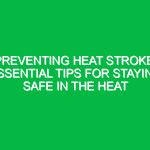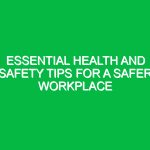Introduction
In the realm of Health, Safety, and Environment (HSE), the concept of the hazard control hierarchy stands as a foundational pillar for effective risk management. This structured approach is not merely a theoretical framework; it is a practical guide designed to systematically address potential hazards in various workplaces, from construction sites to manufacturing floors. Understanding and implementing this hierarchy is crucial for minimizing risks and ensuring the safety of employees and the environment.
The hazard control hierarchy prioritizes methods of risk mitigation, emphasizing that certain strategies are more effective than others in preventing accidents and injuries. By following this hierarchy, organizations can create safer work environments, comply with legal requirements, and foster a culture of safety. This article delves into the critical aspects of the hazard control hierarchy, offering insights and actionable advice to enhance your HSE practices.
The Hazard Control Hierarchy Explained
The hazard control hierarchy, often represented as a pyramid, consists of five key levels of risk control measures, ordered from the most effective to the least effective. The levels are:
- Elimination
- Substitution
- Engineering Controls
- Administrative Controls
- Personal Protective Equipment (PPE)
Each level plays a significant role in managing workplace hazards, and understanding them is essential for HSE success.
1. Elimination
The most effective method of hazard control is elimination. This involves completely removing the hazard from the workplace. For instance, if a particular chemical poses a significant risk, finding a way to eliminate its use altogether is the ideal solution.
Consider a manufacturing plant that uses a harmful substance in its processes. By redesigning the production workflow to eliminate that substance, the organization not only protects its employees but also reduces liability and compliance costs. Eliminating hazards can also lead to increased efficiency, as processes become safer and less complex.
2. Substitution
When elimination is not feasible, substitution becomes the next best option. This involves replacing a hazardous substance or process with a less dangerous one. For example, a company may switch from using a toxic solvent to a non-toxic alternative.
In the automotive industry, manufacturers have shifted from lead-based paints to safer, water-based options. This not only reduces health risks for workers but also aligns with regulatory requirements aimed at minimizing environmental impact. Substitution can often lead to improved workplace morale, as employees feel safer in their environments.
3. Engineering Controls
If elimination and substitution are not viable, engineering controls should be employed. These involve designing equipment or facilities to reduce exposure to hazards. Examples include installing ventilation systems, safety guards on machinery, and soundproofing areas with high noise levels.
A real-world scenario can be seen in construction sites where scaffolding is designed with safety features such as guardrails and toe boards to prevent falls. Such measures do not eliminate the hazard but significantly reduce the risk of injury when hazards cannot be fully removed.
4. Administrative Controls
Administrative controls involve changing the way people work. This includes implementing policies, procedures, and training programs to minimize risk. For instance, rotating employees to limit exposure time to hazardous conditions is a common administrative control.
Consider a laboratory setting where workers handle hazardous materials. Regular training on proper handling procedures, emergency response drills, and clear signage regarding safety protocols are essential in reinforcing safe behaviors. While administrative controls can be effective, they rely heavily on human compliance, making them less reliable than the previous three levels.
5. Personal Protective Equipment (PPE)
The final level of the hazard control hierarchy is personal protective equipment (PPE). While essential, PPE is considered the last line of defense against hazards. This includes items such as helmets, gloves, goggles, and respirators.
A construction worker wearing a hard hat and steel-toed boots is an example of PPE in action. While these items protect against injuries, they do not eliminate the hazard itself. Therefore, relying solely on PPE can create a false sense of security and may not adequately address the root causes of workplace hazards.
Benefits of Implementing the Hazard Control Hierarchy
Adopting the hazard control hierarchy offers numerous benefits that extend beyond mere compliance with safety regulations. These benefits include:
- Improved Safety Outcomes: By prioritizing the most effective control measures, organizations can significantly reduce workplace injuries and fatalities.
- Cost Savings: Reducing accidents minimizes costs associated with workers’ compensation claims, legal fees, and decreased productivity.
- Enhanced Reputation: Companies that prioritize safety are often viewed more favorably by clients, customers, and employees, boosting overall reputation.
- Regulatory Compliance: Following the hazard control hierarchy helps organizations meet legal obligations and avoid penalties.
- Employee Morale: A commitment to safety fosters a positive workplace culture, boosting employee morale and retention rates.
Challenges in Implementing the Hazard Control Hierarchy
While the benefits of the hazard control hierarchy are clear, implementing these controls can present challenges. Organizations may face:
- Resistance to Change: Employees may resist new safety procedures or equipment, especially if they perceive them as inconvenient.
- Cost Considerations: Implementing higher-level controls, such as engineering solutions, may require significant upfront investment.
- Lack of Knowledge: Some organizations may lack the expertise to identify appropriate controls or implement them effectively.
- Insufficient Training: Without thorough training, even well-designed controls can fail if employees do not understand how to use them properly.
Addressing these challenges requires strong leadership commitment, effective communication, and ongoing training and support.
Regulations and Standards Governing Hazard Control Hierarchy
Understanding the legal landscape is essential for effective hazard control. Various regulations and standards govern workplace safety, providing guidelines for implementing the hazard control hierarchy.
For instance, in the United States, the Occupational Safety and Health Administration (OSHA) outlines regulations that require employers to maintain a safe workplace, which includes adhering to the hierarchy of controls. Similarly, the American National Standards Institute (ANSI) provides guidelines that help organizations develop safety management systems.
Internationally, standards set by the International Organization for Standardization (ISO), particularly ISO 45001, emphasize the importance of risk assessment and control hierarchies within occupational health and safety management systems.
Compliance with these regulations not only promotes safety but also protects organizations from legal repercussions and enhances their credibility in the marketplace.
Best Practices for Implementing the Hazard Control Hierarchy
To effectively implement the hazard control hierarchy, organizations should consider these best practices:
- Conduct a Comprehensive Risk Assessment: Identify potential hazards in the workplace and evaluate the risks associated with each.
- Engage Employees: Involve workers in the hazard identification and control process. Their insights can provide valuable information about risks and effective solutions.
- Prioritize Controls: Focus on implementing the highest-level controls first. This ensures that the most effective measures are in place to protect employees.
- Provide Training: Ensure that all employees understand the hazards they face and the controls in place to mitigate those risks.
- Monitor and Review: Regularly review the effectiveness of implemented controls and make adjustments as necessary. This includes staying updated on new regulations and safety practices.
Real-life case studies can illustrate how these best practices lead to successful outcomes. For example, a manufacturing company that involved its employees in risk assessments found innovative solutions and increased compliance with safety protocols, leading to a significant reduction in workplace accidents over a year.
Conclusion
In conclusion, the hazard control hierarchy is an indispensable tool for achieving HSE success. By understanding and applying its principles, organizations can effectively manage risks, enhance workplace safety, and foster a culture of well-being.
The journey toward a safer work environment begins with a commitment to prioritizing the most effective hazard control measures. By eliminating hazards when possible, substituting safer alternatives, implementing engineering controls, enforcing administrative controls, and utilizing personal protective equipment, organizations can protect their most valuable asset: their people.
Encouraging ongoing education and awareness about the hazard control hierarchy will not only comply with regulations but will also cultivate a proactive safety culture. As the workplace evolves, so too must our approaches to safety—making the mastery of the hazard control hierarchy essential for all organizations striving for excellence in health, safety, and environmental management.


